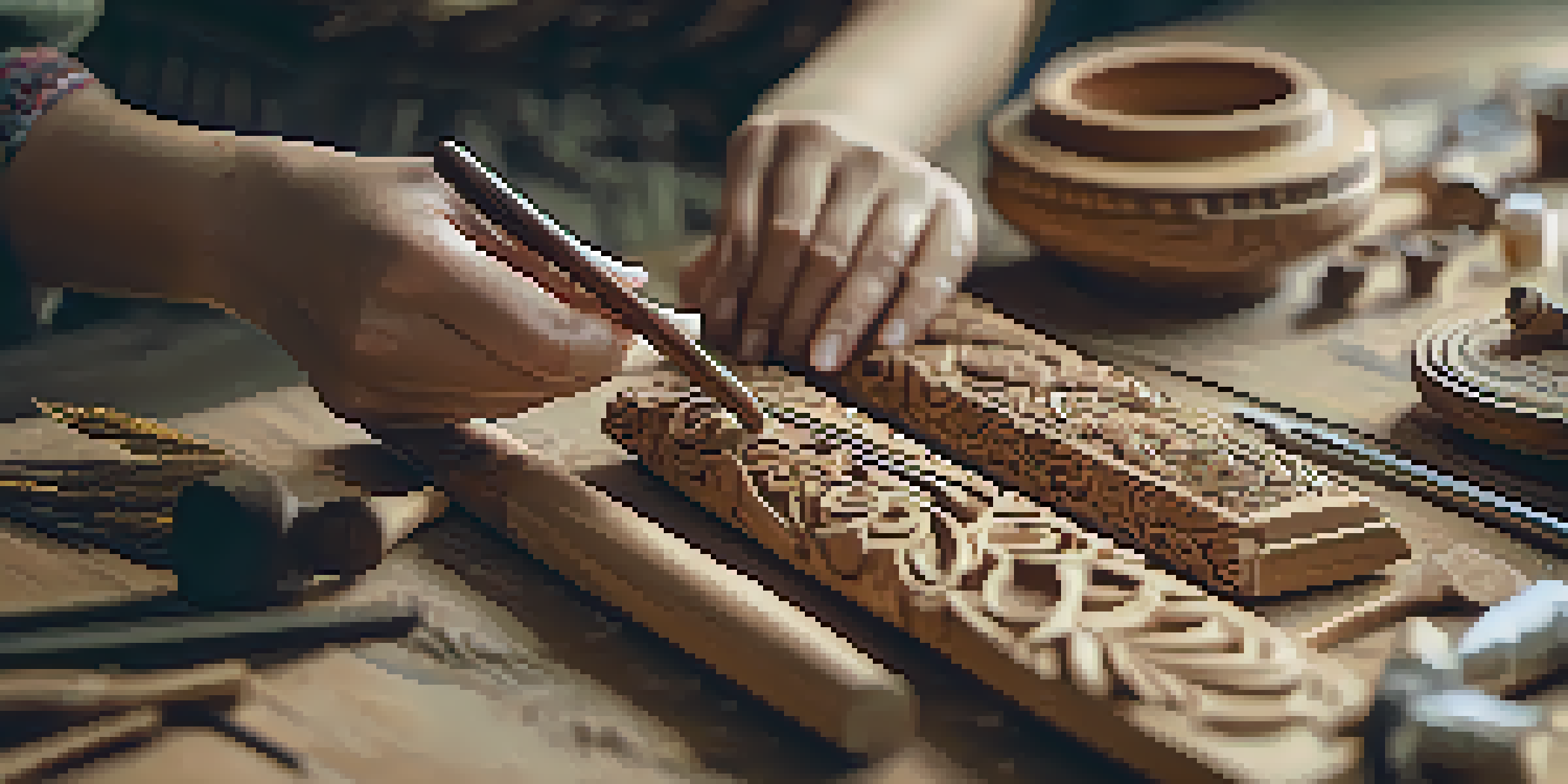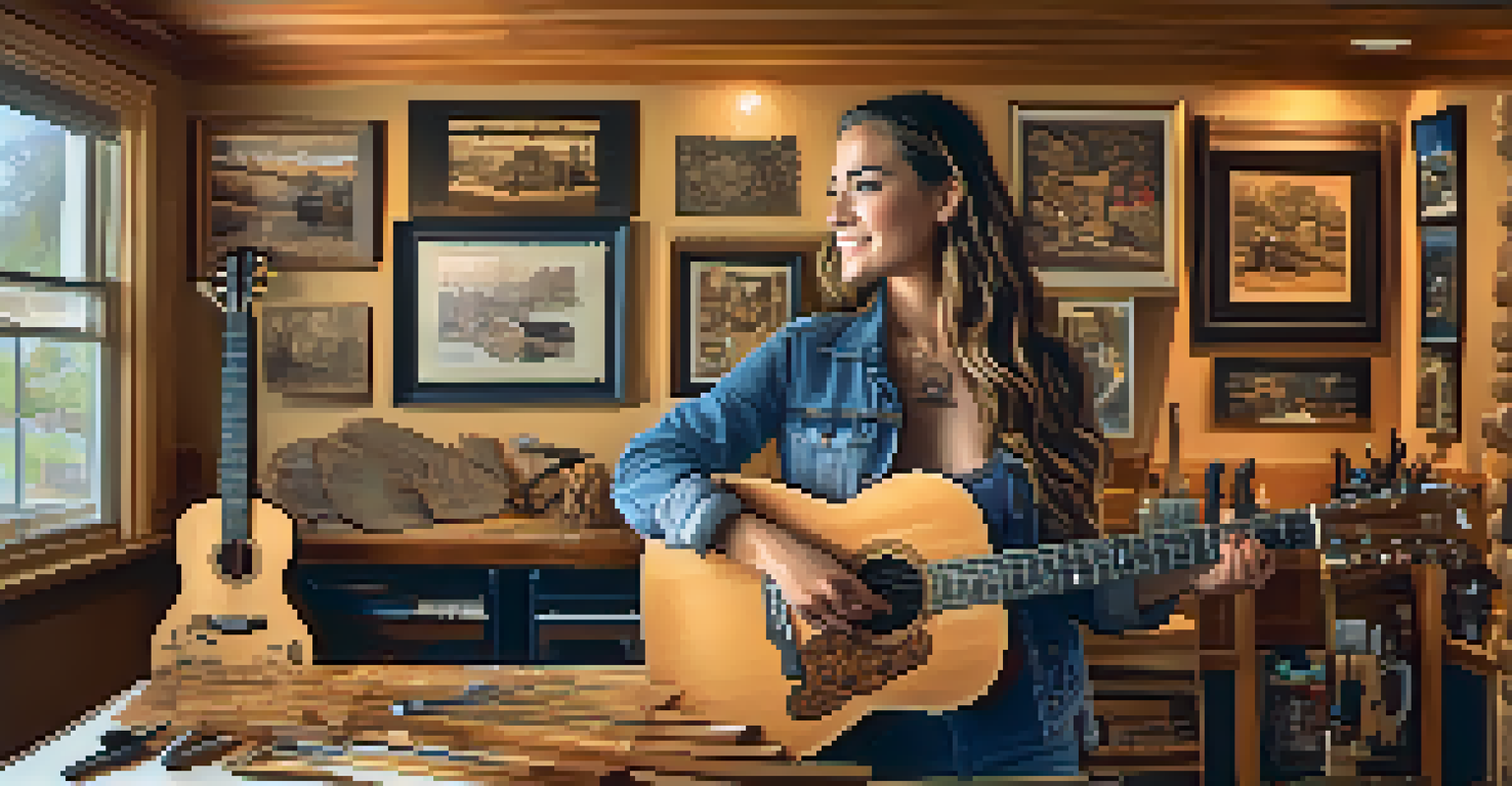Women in Carving: Their Role in Musical Instrument Creation

The Historical Role of Women in Carving Instruments
Throughout history, women have played a crucial role in the crafting of musical instruments, often overlooked in the narrative of woodworking. In many cultures, women were traditionally responsible for the intricate details of instrument carving, such as embellishments and fine tuning. This hands-on involvement not only highlights their skills but also showcases their deep understanding of sound and aesthetics, vital for creating instruments that resonate beautifully.
Music is the shorthand of emotion.
In various regions, particularly in indigenous communities, women have passed down their carving skills through generations. This oral tradition not only preserved techniques but also ensured that the cultural significance of these instruments remained intact. For instance, the creation of ceremonial flutes often involved female artisans, whose work was steeped in both artistry and spiritual significance.
Despite their contributions, many historical accounts have primarily credited male artisans. However, as these narratives shift, we are beginning to recognize women's essential roles in the evolution of musical instrument design. Acknowledging their impact is vital in appreciating the full tapestry of musical history.
Modern Women Carvers: Breaking Barriers
Today, women in the field of musical instrument carving are breaking through traditional barriers and making their mark in what has often been a male-dominated industry. They are not only skilled artisans but also innovators, bringing fresh perspectives to the design and creation process. Many women are now part of leading brands, contributing to the evolution of instruments like guitars, violins, and flutes.

Organizations and workshops dedicated to women in woodworking and carving are sprouting up, providing support and education. These spaces foster creativity and collaboration, allowing women to share techniques and experiences. For example, initiatives like the Women’s Woodworking Network have empowered many to pursue careers in this field, inspiring a new generation of female artisans.
Women's Historic Role in Crafting
Women have significantly contributed to the crafting of musical instruments throughout history, showcasing their skills and deep understanding of sound.
Social media platforms have also played a significant role in showcasing the work of women carvers. By sharing their journeys and creations online, these artisans are inspiring others and building a community where skills and stories can flourish. This visibility helps to challenge stereotypes and encourages more women to consider careers in instrument crafting.
The Crafting Process: Skills and Techniques
Carving instruments requires a unique blend of artistic vision and technical skill, and women have consistently demonstrated both. The process often begins with selecting the right materials, such as different types of wood that offer specific tonal qualities. For instance, spruce is favored for its resonance, while mahogany is known for its warmth—a choice that can significantly impact the final sound of the instrument.
The best way to predict the future is to create it.
Once the materials are chosen, the crafting process involves meticulous carving, shaping, and finishing. Women carvers often employ traditional techniques passed down through generations, alongside modern methods that enhance precision. The attention to detail in this stage is crucial, as even the slightest alteration can affect an instrument's playability and sound.
Beyond technical skills, successful women carvers also bring creativity and innovation to the table. They often experiment with unique designs and features, pushing the boundaries of what is possible in instrument making. This fusion of tradition and innovation not only honors their heritage but also paves the way for future advancements in the field.
The Emotional Connection: Music and Craftsmanship
For many women carving musical instruments, the process is not just about creating a product; it’s about forging a deep emotional connection with music. Each instrument tells a story, and the carver’s personal touch imbues it with character and soul. This connection often inspires women to pour their passion and creativity into every piece they create.
The artistry involved in carving instruments can be likened to composing music itself. Just as a composer considers melody, harmony, and rhythm, a carver contemplates shape, texture, and balance. This parallel highlights the artistry behind the craft and emphasizes that both music and carving require a similar dedication to detail and expression.
Modern Innovations by Women Carvers
Today, women are breaking barriers in the traditionally male-dominated field of instrument carving, bringing fresh perspectives and innovations.
Moreover, many women carvers use their instruments as a means to connect with their communities through music. Whether it's making instruments for local musicians or teaching workshops, these artisans play a vital role in fostering a love for music. This community engagement further solidifies the bond between the craft and its cultural significance.
Challenges Faced by Women in the Crafting Industry
Despite the strides made by women in the carving of musical instruments, challenges still persist. Gender bias in traditionally male-dominated fields can create hurdles, from access to resources to recognition of their work. Many women face skepticism about their skills, often needing to prove themselves in ways their male counterparts may not.
Additionally, balancing the demands of a craft with personal life can be particularly challenging. Many women juggle family responsibilities alongside their careers, which can limit their time and resources for crafting. This balancing act can sometimes lead to feelings of isolation or the risk of burnout as they strive to excel in their artistry.
However, these challenges have also fostered resilience and determination among women in the field. Many have formed supportive networks to share advice, resources, and encouragement, creating a sense of camaraderie. By standing together, they not only uplift each other but also pave the way for future generations of women in the craft.
The Influence of Technology on Instrument Carving
Advancements in technology have significantly impacted the way musical instruments are carved, and women are at the forefront of this transformation. Tools like laser cutters and CNC machines have made precision work more accessible, allowing carvers to explore intricate designs that were once labor-intensive. This shift not only enhances the quality of instruments but also expands creative possibilities.
While technology brings new tools, many women artisans continue to honor traditional methods. This blend of old and new techniques allows them to create unique instruments that reflect both heritage and modernity. For instance, some women incorporate digital designs into their carvings while still using hand tools for finishing touches, resulting in a beautiful fusion of craftsmanship.
Community Support and Resilience
Despite facing challenges, women in the carving industry are forming supportive networks that foster resilience and encourage future generations.
Moreover, the rise of online platforms has enabled women carvers to reach global audiences, showcasing their work beyond local markets. This increased visibility helps them build a brand and connect with musicians who appreciate the artistry behind handcrafted instruments. By harnessing technology, women in carving are not only preserving tradition but also innovating for the future.
Celebrating Women in Carving: A Bright Future Ahead
As we reflect on the contributions of women in the carving of musical instruments, it's essential to celebrate their achievements and recognize the progress made. From historical roots to modern innovations, women have continually shaped the craft, enriching the world of music. Their stories of resilience and creativity inspire others to pursue their passions, regardless of gender.
The future looks promising as more women enter the field, bringing fresh perspectives and diverse voices to the industry. With the support of communities, organizations, and advancements in technology, the landscape of musical instrument crafting is evolving. Women are not just participants; they are leaders, innovators, and role models for aspiring artisans.

As we continue to uplift women in carving, we can look forward to a more inclusive and vibrant future in the world of music. Their artistry will undoubtedly leave a lasting impact, ensuring that the melodies they create resonate for generations to come.